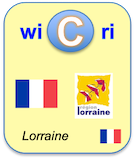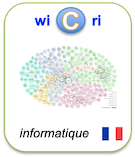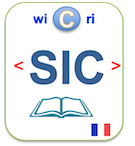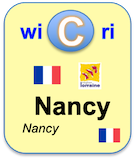Recognizing Knödel graphs
Identifieur interne : 005755 ( Hal/Checkpoint ); précédent : 005754; suivant : 005756Recognizing Knödel graphs
Auteurs : Johanne Cohen [France] ; Pierre Fraigniaud ; Cyril GavoilleSource :
- Discrete Mathematics [ 0012-365X ] ; 2002.
English descriptors
- mix :
Abstract
Given a circulant digraph H=(V,A) of order n and of generators \gamma_0,...,\gamma_k , 0\leq \gamma_i \leq n-1 , i=0,...,k, the bipartite incident-graph of H is a bipartite graph G=(V_1,V_2,E) of order 2n where V_1=V_2=V, and, for any , and any , \{x_1,x_2\}\in E \Leftrightarrow (x_1,x_2)\in A \Leftrightarrow \exists i \in \{0,\dots,k\} \mid x_2 = x_1 + \gamma_i \pmod{n} . Knödel graphs and Fibonacci graphs are two types of such graphs. They correspond to \gamma_i=2^i-1, and \gamma_i=F(i+1)-1 , respectively. Both graphs have been extensively studied for the purpose of fast communications in networks, and they have deserved a lot of attention in this context. In this paper, we show that there exists a polynomial-time algorithm to recognize Knödel graphs, and that the same technique applies to Fibonacci graphs. The algorithm is based on a characterization of the cycles of length six in these graphs (bipartite incident-graphs of circulant digraphs always have cycles of length six). A consequence of our result is that none of the Knödel graphs are edge-transitive, apart those of 2^k-2 vertices. An open problem that arises in this field is to know whether a polynomial-time algorithm exists for any infinite family of bipartite incident-graphs of circulant digraphs indexed by their number of vertices.
Url:
Links toward previous steps (curation, corpus...)
Links to Exploration step
Hal:inria-00100969Le document en format XML
<record><TEI><teiHeader><fileDesc><titleStmt><title xml:lang="it">Recognizing Knödel graphs</title><author><name sortKey="Cohen, Johanne" sort="Cohen, Johanne" uniqKey="Cohen J" first="Johanne" last="Cohen">Johanne Cohen</name><affiliation wicri:level="1"><hal:affiliation type="researchteam" xml:id="struct-2363" status="OLD"><idno type="RNSR">199621458W</idno><orgName>Software Tools for Telecommunications and Distributed Systems</orgName><orgName type="acronym">RESEDAS</orgName><desc><address><country key="FR"></country></address><ref type="url">http://www.inria.fr/equipes/resedas</ref></desc><listRelation><relation active="#struct-160" type="direct"></relation><relation name="UMR7503" active="#struct-441569" type="indirect"></relation><relation active="#struct-300009" type="indirect"></relation><relation active="#struct-300291" type="indirect"></relation><relation active="#struct-300292" type="indirect"></relation><relation active="#struct-300293" type="indirect"></relation><relation active="#struct-2496" type="direct"></relation></listRelation><tutelles><tutelle active="#struct-160" type="direct"><org type="laboratory" xml:id="struct-160" status="OLD"><orgName>Laboratoire Lorrain de Recherche en Informatique et ses Applications</orgName><orgName type="acronym">LORIA</orgName><desc><address><addrLine>Campus Scientifique BP 239 54506 Vandoeuvre-lès-Nancy Cedex</addrLine><country key="FR"></country></address><ref type="url">http://www.loria.fr</ref></desc><listRelation><relation name="UMR7503" active="#struct-441569" type="direct"></relation><relation active="#struct-300009" type="direct"></relation><relation active="#struct-300291" type="direct"></relation><relation active="#struct-300292" type="direct"></relation><relation active="#struct-300293" type="direct"></relation></listRelation></org></tutelle><tutelle name="UMR7503" active="#struct-441569" type="indirect"><org type="institution" xml:id="struct-441569" status="VALID"><idno type="ISNI">0000000122597504</idno><idno type="IdRef">02636817X</idno><orgName>Centre National de la Recherche Scientifique</orgName><orgName type="acronym">CNRS</orgName><date type="start">1939-10-19</date><desc><address><country key="FR"></country></address><ref type="url">http://www.cnrs.fr/</ref></desc></org></tutelle><tutelle active="#struct-300009" type="indirect"><org type="institution" xml:id="struct-300009" status="VALID"><orgName>Institut National de Recherche en Informatique et en Automatique</orgName><orgName type="acronym">Inria</orgName><desc><address><addrLine>Domaine de VoluceauRocquencourt - BP 10578153 Le Chesnay Cedex</addrLine><country key="FR"></country></address><ref type="url">http://www.inria.fr/en/</ref></desc></org></tutelle><tutelle active="#struct-300291" type="indirect"><org type="institution" xml:id="struct-300291" status="OLD"><orgName>Université Henri Poincaré - Nancy 1</orgName><orgName type="acronym">UHP</orgName><date type="end">2011-12-31</date><desc><address><addrLine>24-30 rue Lionnois, BP 60120, 54 003 NANCY cedex, France</addrLine><country key="FR"></country></address></desc></org></tutelle><tutelle active="#struct-300292" type="indirect"><org type="institution" xml:id="struct-300292" status="OLD"><orgName>Université Nancy 2</orgName><date type="end">2011-12-31</date><desc><address><addrLine>91 avenue de la Libération, BP 454, 54001 Nancy cedex</addrLine><country key="FR"></country></address></desc></org></tutelle><tutelle active="#struct-300293" type="indirect"><org type="institution" xml:id="struct-300293" status="OLD"><orgName>Institut National Polytechnique de Lorraine</orgName><orgName type="acronym">INPL</orgName><date type="end">2011-12-31</date><desc><address><country key="FR"></country></address></desc></org></tutelle><tutelle active="#struct-2496" type="direct"><org type="laboratory" xml:id="struct-2496" status="OLD"><orgName>INRIA Lorraine</orgName><desc><address><addrLine>615 rue du Jardin Botanique 54600 Villers-lès-Nancy</addrLine><country key="FR"></country></address><ref type="url">http://www.inria.fr/centre-de-recherche-inria/nancy-grand-est</ref></desc><listRelation><relation active="#struct-300009" type="direct"></relation></listRelation></org></tutelle></tutelles></hal:affiliation><country>France</country><placeName><settlement type="city">Nancy</settlement><region type="region" nuts="2">Grand Est</region><region type="old region" nuts="2">Lorraine (région)</region></placeName><orgName type="university">Université Nancy 2</orgName><orgName type="institution" wicri:auto="newGroup">Université de Lorraine</orgName><placeName><settlement type="city">Nancy</settlement><region type="region" nuts="2">Grand Est</region><region type="old region" nuts="2">Lorraine (région)</region></placeName><orgName type="university">Institut national polytechnique de Lorraine</orgName><orgName type="institution" wicri:auto="newGroup">Université de Lorraine</orgName></affiliation></author><author><name sortKey="Fraigniaud, Pierre" sort="Fraigniaud, Pierre" uniqKey="Fraigniaud P" first="Pierre" last="Fraigniaud">Pierre Fraigniaud</name></author><author><name sortKey="Gavoille, Cyril" sort="Gavoille, Cyril" uniqKey="Gavoille C" first="Cyril" last="Gavoille">Cyril Gavoille</name></author></titleStmt><publicationStmt><idno type="wicri:source">HAL</idno><idno type="RBID">Hal:inria-00100969</idno><idno type="halId">inria-00100969</idno><idno type="halUri">https://hal.inria.fr/inria-00100969</idno><idno type="url">https://hal.inria.fr/inria-00100969</idno><date when="2002">2002</date><idno type="wicri:Area/Hal/Corpus">006B80</idno><idno type="wicri:Area/Hal/Curation">006B80</idno><idno type="wicri:Area/Hal/Checkpoint">005755</idno><idno type="wicri:explorRef" wicri:stream="Hal" wicri:step="Checkpoint">005755</idno></publicationStmt><sourceDesc><biblStruct><analytic><title xml:lang="it">Recognizing Knödel graphs</title><author><name sortKey="Cohen, Johanne" sort="Cohen, Johanne" uniqKey="Cohen J" first="Johanne" last="Cohen">Johanne Cohen</name><affiliation wicri:level="1"><hal:affiliation type="researchteam" xml:id="struct-2363" status="OLD"><idno type="RNSR">199621458W</idno><orgName>Software Tools for Telecommunications and Distributed Systems</orgName><orgName type="acronym">RESEDAS</orgName><desc><address><country key="FR"></country></address><ref type="url">http://www.inria.fr/equipes/resedas</ref></desc><listRelation><relation active="#struct-160" type="direct"></relation><relation name="UMR7503" active="#struct-441569" type="indirect"></relation><relation active="#struct-300009" type="indirect"></relation><relation active="#struct-300291" type="indirect"></relation><relation active="#struct-300292" type="indirect"></relation><relation active="#struct-300293" type="indirect"></relation><relation active="#struct-2496" type="direct"></relation></listRelation><tutelles><tutelle active="#struct-160" type="direct"><org type="laboratory" xml:id="struct-160" status="OLD"><orgName>Laboratoire Lorrain de Recherche en Informatique et ses Applications</orgName><orgName type="acronym">LORIA</orgName><desc><address><addrLine>Campus Scientifique BP 239 54506 Vandoeuvre-lès-Nancy Cedex</addrLine><country key="FR"></country></address><ref type="url">http://www.loria.fr</ref></desc><listRelation><relation name="UMR7503" active="#struct-441569" type="direct"></relation><relation active="#struct-300009" type="direct"></relation><relation active="#struct-300291" type="direct"></relation><relation active="#struct-300292" type="direct"></relation><relation active="#struct-300293" type="direct"></relation></listRelation></org></tutelle><tutelle name="UMR7503" active="#struct-441569" type="indirect"><org type="institution" xml:id="struct-441569" status="VALID"><idno type="ISNI">0000000122597504</idno><idno type="IdRef">02636817X</idno><orgName>Centre National de la Recherche Scientifique</orgName><orgName type="acronym">CNRS</orgName><date type="start">1939-10-19</date><desc><address><country key="FR"></country></address><ref type="url">http://www.cnrs.fr/</ref></desc></org></tutelle><tutelle active="#struct-300009" type="indirect"><org type="institution" xml:id="struct-300009" status="VALID"><orgName>Institut National de Recherche en Informatique et en Automatique</orgName><orgName type="acronym">Inria</orgName><desc><address><addrLine>Domaine de VoluceauRocquencourt - BP 10578153 Le Chesnay Cedex</addrLine><country key="FR"></country></address><ref type="url">http://www.inria.fr/en/</ref></desc></org></tutelle><tutelle active="#struct-300291" type="indirect"><org type="institution" xml:id="struct-300291" status="OLD"><orgName>Université Henri Poincaré - Nancy 1</orgName><orgName type="acronym">UHP</orgName><date type="end">2011-12-31</date><desc><address><addrLine>24-30 rue Lionnois, BP 60120, 54 003 NANCY cedex, France</addrLine><country key="FR"></country></address></desc></org></tutelle><tutelle active="#struct-300292" type="indirect"><org type="institution" xml:id="struct-300292" status="OLD"><orgName>Université Nancy 2</orgName><date type="end">2011-12-31</date><desc><address><addrLine>91 avenue de la Libération, BP 454, 54001 Nancy cedex</addrLine><country key="FR"></country></address></desc></org></tutelle><tutelle active="#struct-300293" type="indirect"><org type="institution" xml:id="struct-300293" status="OLD"><orgName>Institut National Polytechnique de Lorraine</orgName><orgName type="acronym">INPL</orgName><date type="end">2011-12-31</date><desc><address><country key="FR"></country></address></desc></org></tutelle><tutelle active="#struct-2496" type="direct"><org type="laboratory" xml:id="struct-2496" status="OLD"><orgName>INRIA Lorraine</orgName><desc><address><addrLine>615 rue du Jardin Botanique 54600 Villers-lès-Nancy</addrLine><country key="FR"></country></address><ref type="url">http://www.inria.fr/centre-de-recherche-inria/nancy-grand-est</ref></desc><listRelation><relation active="#struct-300009" type="direct"></relation></listRelation></org></tutelle></tutelles></hal:affiliation><country>France</country><placeName><settlement type="city">Nancy</settlement><region type="region" nuts="2">Grand Est</region><region type="old region" nuts="2">Lorraine (région)</region></placeName><orgName type="university">Université Nancy 2</orgName><orgName type="institution" wicri:auto="newGroup">Université de Lorraine</orgName><placeName><settlement type="city">Nancy</settlement><region type="region" nuts="2">Grand Est</region><region type="old region" nuts="2">Lorraine (région)</region></placeName><orgName type="university">Institut national polytechnique de Lorraine</orgName><orgName type="institution" wicri:auto="newGroup">Université de Lorraine</orgName></affiliation></author><author><name sortKey="Fraigniaud, Pierre" sort="Fraigniaud, Pierre" uniqKey="Fraigniaud P" first="Pierre" last="Fraigniaud">Pierre Fraigniaud</name></author><author><name sortKey="Gavoille, Cyril" sort="Gavoille, Cyril" uniqKey="Gavoille C" first="Cyril" last="Gavoille">Cyril Gavoille</name></author></analytic><series><title level="j">Discrete Mathematics</title><idno type="ISSN">0012-365X</idno><imprint><date type="datePub">2002</date></imprint></series></biblStruct></sourceDesc></fileDesc><profileDesc><textClass><keywords scheme="mix" xml:lang="en"><term>anneau à corde</term><term>chordal ring</term><term>circulant digraph</term><term>gossiping.</term><term>graph isomorphism</term><term>graphe circulant</term><term>isomorphisme de graphes</term><term>échange total</term><term>échange total.</term></keywords></textClass></profileDesc></teiHeader><front><div type="abstract" xml:lang="en">Given a circulant digraph H=(V,A) of order n and of generators \gamma_0,...,\gamma_k , 0\leq \gamma_i \leq n-1 , i=0,...,k, the bipartite incident-graph of H is a bipartite graph G=(V_1,V_2,E) of order 2n where V_1=V_2=V, and, for any , and any , \{x_1,x_2\}\in E \Leftrightarrow (x_1,x_2)\in A \Leftrightarrow \exists i \in \{0,\dots,k\} \mid x_2 = x_1 + \gamma_i \pmod{n} . Knödel graphs and Fibonacci graphs are two types of such graphs. They correspond to \gamma_i=2^i-1, and \gamma_i=F(i+1)-1 , respectively. Both graphs have been extensively studied for the purpose of fast communications in networks, and they have deserved a lot of attention in this context. In this paper, we show that there exists a polynomial-time algorithm to recognize Knödel graphs, and that the same technique applies to Fibonacci graphs. The algorithm is based on a characterization of the cycles of length six in these graphs (bipartite incident-graphs of circulant digraphs always have cycles of length six). A consequence of our result is that none of the Knödel graphs are edge-transitive, apart those of 2^k-2 vertices. An open problem that arises in this field is to know whether a polynomial-time algorithm exists for any infinite family of bipartite incident-graphs of circulant digraphs indexed by their number of vertices.</div></front></TEI><hal api="V3"><titleStmt><title xml:lang="it">Recognizing Knödel graphs</title><author role="aut"><persName><forename type="first">Johanne</forename><surname>Cohen</surname></persName><email>Johanne.Cohen@loria.fr</email><idno type="idhal">johanne-cohen</idno><idno type="halauthor">130677</idno><orgName ref="#struct-441569"></orgName><affiliation ref="#struct-2363"></affiliation></author><author role="aut"><persName><forename type="first">Pierre</forename><surname>Fraigniaud</surname></persName><email></email><idno type="halauthor">130082</idno><orgName ref="#struct-364576"></orgName></author><author role="aut"><persName><forename type="first">Cyril</forename><surname>Gavoille</surname></persName><email></email><idno type="halauthor">132176</idno><orgName ref="#struct-365238"></orgName></author><editor role="depositor"><persName><forename>Publications</forename><surname>Loria</surname></persName><email>publications@loria.fr</email></editor></titleStmt><editionStmt><edition n="v1" type="current"><date type="whenSubmitted">2006-09-26 14:53:13</date><date type="whenModified">2016-05-19 01:09:09</date><date type="whenReleased">2006-09-28 15:22:47</date><date type="whenProduced">2002</date></edition><respStmt><resp>contributor</resp><name key="108626"><persName><forename>Publications</forename><surname>Loria</surname></persName><email>publications@loria.fr</email></name></respStmt></editionStmt><publicationStmt><distributor>CCSD</distributor><idno type="halId">inria-00100969</idno><idno type="halUri">https://hal.inria.fr/inria-00100969</idno><idno type="halBibtex">cohen:inria-00100969</idno><idno type="halRefHtml">Discrete Mathematics, Elsevier, 2002, pp.41-62</idno><idno type="halRef">Discrete Mathematics, Elsevier, 2002, pp.41-62</idno></publicationStmt><seriesStmt><idno type="stamp" n="INRIA">INRIA - Institut National de Recherche en Informatique et en Automatique</idno><idno type="stamp" n="CNRS">CNRS - Centre national de la recherche scientifique</idno><idno type="stamp" n="INPL">Institut National Polytechnique de Lorraine</idno><idno type="stamp" n="LORIA2">Publications du LORIA</idno><idno type="stamp" n="LORIA">LORIA - Laboratoire Lorrain de Recherche en Informatique et ses Applications</idno><idno type="stamp" n="INRIA-NANCY-GRAND-EST">INRIA Nancy - Grand Est</idno><idno type="stamp" n="UNIV-LORRAINE">Université de Lorraine</idno><idno type="stamp" n="INRIA-LORRAINE">INRIA Nancy - Grand Est</idno><idno type="stamp" n="LABO-LORIA-SET" p="LORIA">LABO-LORIA-SET</idno></seriesStmt><notesStmt><note type="commentary">Article dans revue scientifique avec comité de lecture.</note><note type="audience" n="1">Not set</note><note type="popular" n="0">No</note><note type="peer" n="1">Yes</note></notesStmt><sourceDesc><biblStruct><analytic><title xml:lang="it">Recognizing Knödel graphs</title><author role="aut"><persName><forename type="first">Johanne</forename><surname>Cohen</surname></persName><email>Johanne.Cohen@loria.fr</email><idno type="idHal">johanne-cohen</idno><idno type="halAuthorId">130677</idno><orgName ref="#struct-441569"></orgName><affiliation ref="#struct-2363"></affiliation></author><author role="aut"><persName><forename type="first">Pierre</forename><surname>Fraigniaud</surname></persName><idno type="halAuthorId">130082</idno><orgName ref="#struct-364576"></orgName></author><author role="aut"><persName><forename type="first">Cyril</forename><surname>Gavoille</surname></persName><idno type="halAuthorId">132176</idno><orgName ref="#struct-365238"></orgName></author></analytic><monogr><idno type="localRef">A02-R-427 || cohen02b</idno><idno type="halJournalId" status="VALID">12623</idno><idno type="issn">0012-365X</idno><title level="j">Discrete Mathematics</title><imprint><publisher>Elsevier</publisher><biblScope unit="issue">250</biblScope><biblScope unit="pp">41-62</biblScope><date type="datePub">2002</date></imprint></monogr></biblStruct></sourceDesc><profileDesc><langUsage><language ident="en">English</language></langUsage><textClass><keywords scheme="author"><term xml:lang="en">échange total.</term><term xml:lang="en">isomorphisme de graphes</term><term xml:lang="en">gossiping.</term><term xml:lang="en">graph isomorphism</term><term xml:lang="en">circulant digraph</term><term xml:lang="en">chordal ring</term><term xml:lang="en">graphe circulant</term><term xml:lang="en">anneau à corde</term><term xml:lang="en">échange total</term></keywords><classCode scheme="halDomain" n="info.info-oh">Computer Science [cs]/Other [cs.OH]</classCode><classCode scheme="halTypology" n="ART">Journal articles</classCode></textClass><abstract xml:lang="en">Given a circulant digraph H=(V,A) of order n and of generators \gamma_0,...,\gamma_k , 0\leq \gamma_i \leq n-1 , i=0,...,k, the bipartite incident-graph of H is a bipartite graph G=(V_1,V_2,E) of order 2n where V_1=V_2=V, and, for any , and any , \{x_1,x_2\}\in E \Leftrightarrow (x_1,x_2)\in A \Leftrightarrow \exists i \in \{0,\dots,k\} \mid x_2 = x_1 + \gamma_i \pmod{n} . Knödel graphs and Fibonacci graphs are two types of such graphs. They correspond to \gamma_i=2^i-1, and \gamma_i=F(i+1)-1 , respectively. Both graphs have been extensively studied for the purpose of fast communications in networks, and they have deserved a lot of attention in this context. In this paper, we show that there exists a polynomial-time algorithm to recognize Knödel graphs, and that the same technique applies to Fibonacci graphs. The algorithm is based on a characterization of the cycles of length six in these graphs (bipartite incident-graphs of circulant digraphs always have cycles of length six). A consequence of our result is that none of the Knödel graphs are edge-transitive, apart those of 2^k-2 vertices. An open problem that arises in this field is to know whether a polynomial-time algorithm exists for any infinite family of bipartite incident-graphs of circulant digraphs indexed by their number of vertices.</abstract></profileDesc></hal></record>Pour manipuler ce document sous Unix (Dilib)
EXPLOR_STEP=$WICRI_ROOT/Wicri/Lorraine/explor/InforLorV4/Data/Hal/Checkpoint
HfdSelect -h $EXPLOR_STEP/biblio.hfd -nk 005755 | SxmlIndent | more
Ou
HfdSelect -h $EXPLOR_AREA/Data/Hal/Checkpoint/biblio.hfd -nk 005755 | SxmlIndent | more
Pour mettre un lien sur cette page dans le réseau Wicri
{{Explor lien
|wiki= Wicri/Lorraine
|area= InforLorV4
|flux= Hal
|étape= Checkpoint
|type= RBID
|clé= Hal:inria-00100969
|texte= Recognizing Knödel graphs
}}
|
| This area was generated with Dilib version V0.6.33. | |



